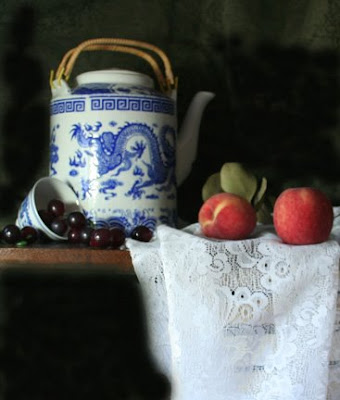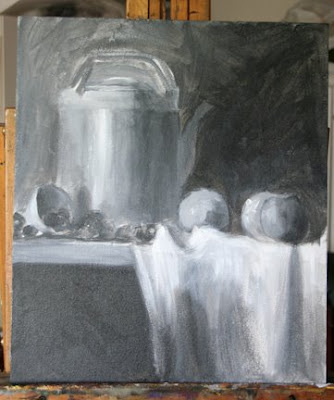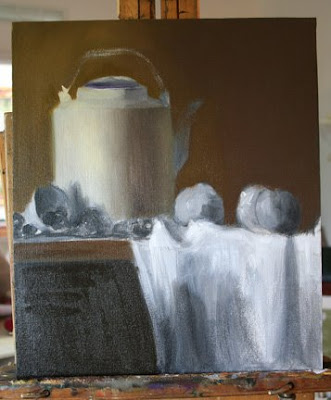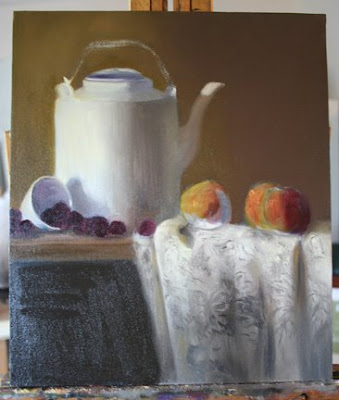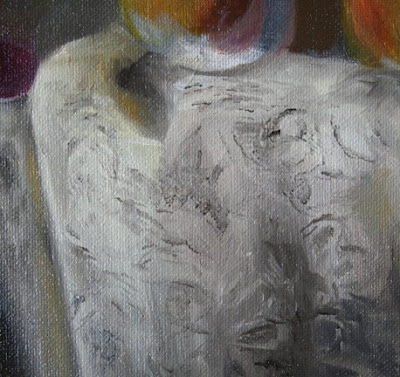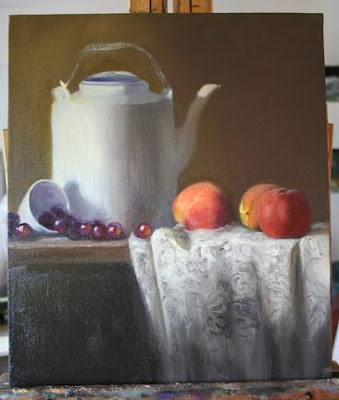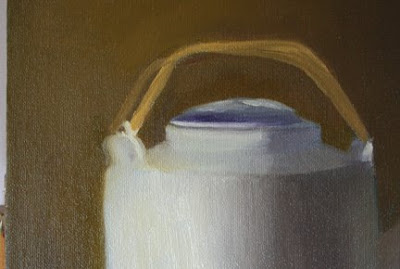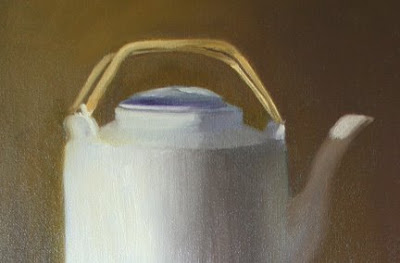8" x 10" Oil on Panel


I've been wanting to do Orchids for some time and so I got busy early today and set these up in my shadow box. So here's the set-up.
I used to paint very hard edged reflections when I first started painting still life and have since gone to a softer more romantic look. We'll talk more about that as the lesson progresses.
I'm currently unable to paint by natural light due to the fact that my windows are no longer looking out on the world but on the inside of my new, presently unfinished studio. While there's a beautiful seven foot arched window that faces north in there, none of the light reaches my old studio. When they punch through to the old studio, that room will become my new office and I can set up my still life's under the beautiful soft north light that comes in from the arched window. In the meantime, I'm using a plant light that sort of replicates natural light, but still tends to the warm side. Hence, the rather gold looking tones in the silver bowl.
I started by laying in a basic sketch of the still life with some raw umber and mineral spirits. The yellow ochre background you see is the color of the gesso I used to tone the board. Daniel Smith makes it and I like it because it saves me the trouble of toning a board a few days before I start to work. I don't always know in advance what I'm going to want and also don't have enough spare boards on hand a lot of the time to create diversity.
Working on a toned surface is important because it allows you to better judge values (lights and darks). There I go again talking about values. But they're soooo important.
I did the background first and reserved the shapes of the flowers. Note that in ala prima painting, you try as much as possible to reserve the areas where you are going to place flowers because it's too easy to muddy the colors otherwise.
I used Viridian Green, Raw Umber, and touches of Ultramarine Blue in making the background. I chose the Viridian because it's bluish tint would set off the reds in the flowers without making them too vibrant. The lighter areas were lightened with a touch of Naples Yellow because it's less cool than white. I wanted it a bit lighter where the second bunch of blooms fall because that's where the lightest petals will be and I wanted to lighten the "air" around the flower.
The color of the flowers is mixed with Daniel Smith's Quinacridone Pink. His Quinacridone colors are very intense and don't lose their intensity when you mix them with white. I used a bit of Alazarin Crimson and Ultramarine Blue for the shadow parts and Cadmium Red Light for the center petals.
Note that I use the largest brush that can get the job done. I start with a single stroke - beginning and ending the stroke. I don't go back in and belabor it. That's not to say that I don't use smaller brushes for the detail and places where the petals have highlights on them, but I try to use a loaded brush and get the stroke right on the first try. I'm not always successful. But I'd rather wipe it off and try again, than have an overworked flower.
The pot here is started with Burnt Umber and also some of the background color mixed in. This is important to do in order to give the pot the appearance of being part of its environment. Air, so to speak.
Here I've started to put in some of the background flowers. I'm not working too hard to bring detail into these. You can't see detail from the distance I'm sitting at so why should the viewer have to see it. It's important to keep that in mind. I hear from my students a lot that they "can't see" well enough to get these vague areas. Precisely. That is the point. They are vague.
I'm using Naples Yellow on the pot to bring out the patina. I don't want a hard highlight even though that's what appears before me because of the artificial light. So I lay in the paint and then soften the edges moving out from the center with my brush. You can see a bit of Burnt Umber on the pot here where I've warmed it up to bring it forward in the bulge. I've started the reflection of the cloth, making sure to keep my edges very soft. Inside the pot there's some lovely reflections of the petals but they look a bit orangey to me, so I've tentatively started them that way. They'll likely change as the painting progresses because my eyes will adjust further and color relationships will become clearer to me.
Here the second flower is in and you can see how the bloom is a lot brighter. The picture is a bit on the light side here because I have an Ott Light above it. I've made better adjustments for this in the final picture.
I've put some color into the inside of the pot. A bit of Burnt Sienna and Naples Yellow with Burnt Umber for the darker areas. I've still reserved that orangey spot.
The last of the blooms are in here except for two. Nothing much has changed in the pot at this point except I've darkened a band around the rim.
Sorry for the glare here. It's very hard to see on the camera when I'm taking the shots. The light in the studio is so carefully set with overheads off and separate lights dimmed and directed away from the still life, that it's too dark to just snap a shot. I need to use a longer exposure that tends to pick up more light from other sources than I can see on the lCD display.
I've added the reflections from the blooms on the pot and also brightened the rim of the pot. Nothing much done on the inside yet.
My timer didn't go off so almost 20 minutes elapsed here. The last two flower have been added and I also put in the stems of the flowers. The stems are made up of some of the Viridian Green and a bit of Cadmium Yellow Light.
On the fruit, I started by laying in the core shadow shapes with a darker (OK, I know it doesn't look light) mixture of Viridian and Burnt Umber. You can see this on the apple to the left. The cast shadows were laid in with Burnt Umber on the table portion and a shadow mix of Ivory Black, Cad Yellow Light and White on the table cloth. I brushed in a bit of Yellow Ochre in both shadows to make them more transparent.
The apple color was basically Viridian, Cad Yellow Light with a bit of Cad Red Light to tone the hue. I used the darker mixture of Viridian and Burnt Umber for the turning edges and shadows on the apples slices.
Note the Yellow Ochre in the table cloth. Adding a bit of this or Cadmium Yellow Medium will make a white cloth glow when used sparingly in the shadows where you see light coming through the cloth.
The pot is looking up here. I've rounded the shape a bit and added a highlight to the rim of the pot. I'm starting to see more color in the interior but won't add it until later.
This is the finished painting but it took another hour or so to get here.
The lights on the apple are in. Simple combo of Viridian Green, Cad Yellow Light and some white on the highlight portion. The stem was just some dark Burn Umber.
I've added the reflections of the fruit to the pot and brushed some more color from the flower into the bulge of the pot in the front to bring it forward. Note that the reflections in the pot are vague. I didn't make them sharp edged because to do so in this type of painting only confuses the viewer.
The apple core color is Naples Yellow and a touch of Cadmium Yellow Medium. The pits are just a smidge of Burn Sienna.
For the table top, I used some Burn Sienna, Naples Yellow and touches of white to bring out the area where the light is hitting it. The front of the table is just a darker version of this color with smudges of Burn Umber and background color.
For the handles and foot of the pot, Just some small blobs of Naples Yellow and White mixture on a vaguely painted handle of Raw Umber. Note the shadow of the handle on the left side. This pops the handle and helps to give a dimension of reality. It's these little touches that make all the difference. Thanks for stopping by!
If you'd like to purchase this painting, visit my blog at www.susanmartinspar.blogspot.com and click on the "Buy Now" button. You don't need a PayPal account and can choose to use just your credit card. $99.00 USD plus $15.00 S/H.








